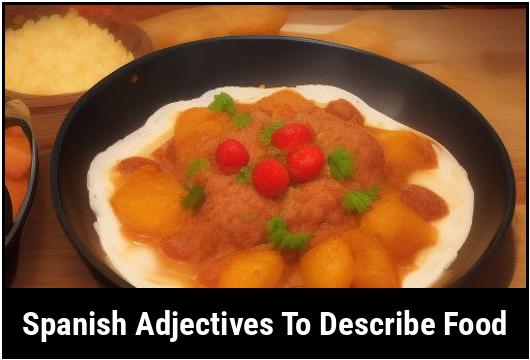- You are here:
- Home »
- adjectives
- » 31 Spanish Adjectives To Describe Food

31 Spanish Adjectives To Describe Food
In the world of gastronomy, the flavors, textures, and aromas of food are often as important as the ingredients themselves. When it comes to describing food, adjectives play a vital role in articulating the sensory experience. In the realm of the Spanish language, a rich tapestry of adjectives exists to describe the myriad qualities of different culinary delights. With adjectives ranging from savory to sweet, tangy to tender, Spanish provides a diverse array of descriptors to paint a vivid picture of the gastronomic experience. This article delves into the world of Spanish adjectives that are used to describe food, providing an overview of their significance and categorization.
Key Takeaways
- Spanish adjectives are crucial for conveying the sensory experience of food, encompassing taste, texture, aroma, and appearance.
- Choosing the right adjective to describe food entails considering the specific qualities and characteristics of the dish being discussed.
- Different types of adjectives, such as sensory, appearance-based, and origins-based, serve distinct purposes in describing food in Spanish.
Spanish Adjectives To Describe Food
1. Delicioso – Delicious
The perfect word to capture the mouthwatering flavors that Spanish cuisine has to offer. From paella to tapas, every bite is an explosion of taste.
2. Sabroso – Tasty
A versatile adjective that can be used to describe anything from a simple tortilla de patatas (potato omelet) to a juicy steak grilled to perfection.
3. Picante – Spicy
Used to describe food that packs a punch with its fiery heat, picante is the adjective to use for those who love a little kick in their dishes.
4. Caliente – Hot
Used to describe both temperature and spiciness, caliente is the perfect adjective for dishes that are served piping hot or have a fiery flavor.
5. Frío – Cold
Ideal for describing refreshing dishes like gazpacho (cold tomato soup) or a chilled glass of sangria on a hot summer day.
6. Fresco – Fresh
Used to describe dishes made with the finest and most recently harvested ingredients, fresco showcases the incredible quality and flavors of Spanish produce.
7. Tierno – Tender
Captures the tenderness of slow-cooked meats, like the famous Cochinillo Asado (roast suckling pig), where the meat effortlessly falls off the bone.
8. Jugoso – Juicy
The perfect word to describe succulent fruits or the perfectly grilled steak that retains its juices, leaving you wanting more.
9. Crujiente – Crunchy
Used to describe the satisfying sound and texture of foods with a crispy crust, such as churros or cojonudos (fried bread topped with ham and poached eggs).
10. Suave – Smooth
Ideal for describing creamy dishes, desserts, or velvety sauces that glide effortlessly on the palate, leaving a lingering taste.
11. Esponjoso – Fluffy
Used to describe light and airy foods, like the delicate Spanish omelet or a freshly baked pan de cristal (glass bread).
12. Grasoso – Greasy
Though not necessarily negative, grasoso is the adjective to describe dishes with a generous amount of oil or fat, like patatas bravas (fried potatoes with a spicy tomato sauce).
13. Agridulce – Bittersweet
Perfect for describing the delightful combination of contrasting flavors, like the sweetness of caramelized onions with a slightly bitter touch.
14. Ácido – Sour
Ideal for describing dishes that have a tangy or acidic taste, such as lemon-flavored desserts or a refreshing glass of tinto de verano (red wine with soda).
15. Amargo – Bitter
Used to describe foods that have a bitter taste, like dark chocolate or some varieties of olives, appreciated by those with an acquired taste.
16. Dulce – Sweet
A versatile and essential adjective to describe Spanish delicacies like turron (nougat), churros sprinkled with sugar, or the beloved flan.
17. Salado – Salty
Perfect for describing dishes with a savory and salted flavor profile, like olives, jamón ibérico (Iberian ham), or boquerones (marinated anchovies).
18. Ahumado – Smoky
An adjective that beautifully captures the flavors of dishes prepared with smoke, such as chorizo or the famous pulpo a la gallega (Galician-style octopus).
19. Sabrosón – Flavorful
An intensified version of "sabroso," this adjective highlights dishes bursting with rich, intense, and unforgettable flavors.
20. Ligero – Light
Ideal for describing dishes that are not heavy or overly rich, like brothy soups or delicate seafood preparations.
21. Saciante – Satisfying
Used to describe a dish that leaves you feeling content and satisfied, like a steaming bowl of Cocido Madrileño (hearty Madrid stew).
22. Exquisito – Exquisite
An adjective that emphasizes the exceptional quality and taste of a dish, making it perfect for decadent desserts, premium seafood, or gourmet creations.
23. Nutritivo – Nutritious
Used to describe dishes packed with essential nutrients and beneficial properties, showcasing Spanish cuisine’s focus on wholesome ingredients.
24. Ligero – Refreshing
Perfect for dishes that are cooling or have a revitalizing effect, like a refreshing glass of horchata (tiger nut milk) or a cucumber salad.
25. Especiado – Spiced
Used to describe dishes that are rich in aromatic spices, like a flavorful curry or typical Spanish rice dishes like arroz a la valenciana.
26. Sencillo – Simple
Describes dishes with a straightforward preparation and uncomplicated flavors that highlight the natural taste of the ingredients.
27. Complejo – Complex
Ideal for dishes with intricate flavors and combinations, showcasing the artistry and creativity of Spanish chefs.
28. Ligero – Balanced
Perfectly describes dishes with a harmonious blend of flavors, where no single taste overpowers the others.
29. Jugoso – Savory
Ideal for describing dishes with intense umami flavors, like jamón ibérico or a hearty pot of fabada asturiana (Asturian bean stew).
30. Delicado – Delicate
Used to describe food that requires careful handling or has subtle flavors that can be easily overwhelmed, like grilled fish or delicate pastries.
31. Sachíchimo – Aromatic
An indigenous adjective from Spain’s Mapuche language, sachíchimo aptly describes dishes that burst with fragrant and aromatic flavors, like authentic Spanish saffron-infused rice or hearty stews with indigenous spices.
Why Use Adjectives To Describe Food
Adjectives are indispensable in the culinary realm as they go beyond the mere identification of dishes. They provide a sensory and emotive dimension to the description of food, allowing speakers and writers to convey the subtle nuances and complexities of various culinary experiences. In the context of Spanish cuisine, adjectives form an intrinsic part of the cultural and linguistic identity, reflecting the deep appreciation and reverence for food and its preparation. Whether used in casual conversations, restaurant menus, or literary works, adjectives create a visual and palatable portrayal of the gastronomic world. They evoke nostalgia, provoke cravings, and elevate the appreciation of food, making them a fundamental element of Spanish culinary discourse.
How To Choose The Right Adjective To Describe Food
Selecting the apt adjective to describe food is a nuanced endeavor that takes into account different aspects of the dish. The choice of adjective depends on factors such as taste, texture, aroma, appearance, and even cultural associations. Assessing the specific qualities of the food and considering the desired effect on the listener or reader are essential steps in this process. For instance, a succulent steak might be described using an adjective that emphasizes its tenderness, while a zesty citrus dessert could be portrayed through adjectives highlighting its tangy flavor. Context and audience also play a pivotal role, as the same dish may be described differently based on whether the communication is informal, formal, or technical in nature.
Types Of Adjectives For Describing Food
1. Sensory Adjectives
Sensory adjectives form the backbone of describing food, encompassing taste, aroma, texture, and mouthfeel. These adjectives are instrumental in articulating the sensorial experience of consuming different dishes. In the realm of Spanish cuisine, sensory adjectives play a key role in conveying the diverse and vibrant flavors that abound in the culinary landscape. They range from adjectives denoting the richness of flavors to those describing the delicate textures of various food items. For example, "dulce" (sweet), "salado" (salty), "cremoso" (creamy), and "especiado" (spiced) are all sensory adjectives that contribute to the vivid portrayal of food in Spanish.
2. Appearance-based Adjectives
Appearance-based adjectives elucidate the visual aspect of food, capturing its aesthetic appeal and presentation. In Spanish, an array of adjectives is employed to depict the visual allure of different dishes, ranging from vibrant and fresh fruits and vegetables to decadent and indulgent desserts. These adjectives often evoke imagery, color, and shape, thereby enhancing the sensory experience even before the first bite. From "colorido" (colorful) to "brillante" (shiny), and "esponjoso" (fluffy) to "crunchy" (crujiente), appearance-based adjectives in Spanish provide a visual feast for the imagination.
3. Origins-based Adjectives
Origins-based adjectives are tied to the geographical, cultural, or historical roots of a dish, providing insight into its culinary heritage and provenance. In the context of Spanish cuisine, these adjectives offer a glimpse into the diverse regional specialties and traditional dishes that contribute to the country’s gastronomic tapestry. Adjectives such as "andaluz" (Andalusian), "vasco" (Basque), "castellano" (Castilian), and "gallego" (Galician) not only convey the geographic origin of a dish but also hint at the unique flavors and techniques associated with a particular region.
The art of describing food in Spanish is a nuanced and sensory-rich endeavor that relies heavily on the use of adjectives. From elevating the sensory experience to evoking cultural and visual imagery, adjectives play a pivotal role in articulating the diverse and vibrant culinary landscape of the Spanish-speaking world. By carefully selecting and employing adjectives that encompass taste, texture, aroma, appearance, and cultural significance, speakers and writers can paint a rich and evocative portrayal of the gastronomic wonders that abound in Spanish cuisine. Embracing the richness of Spanish adjectives for describing food not only enhances the appreciation of culinary delights but also serves as a testament to the linguistic and cultural significance of food in the Spanish-speaking world.
Examples Of Adjectives For Different Types Of Food
When it comes to describing food in Spanish, using the appropriate adjectives can make a huge difference in how accurately and vividly you can paint a picture of the flavor, texture, and appearance of a dish. Whether you are trying to convey the intense spiciness of a Mexican salsa or the delicate sweetness of a Spanish dessert, having a good grasp of descriptive adjectives is essential.
1. Taste
-
Delicioso/a (Delicious): This adjective is used to describe food that tastes extremely good or is very enjoyable. For example, "La paella está deliciosa" (The paella is delicious).
-
Sabroso/a (Tasty): This adjective is similar to "delicioso," but it emphasizes the taste rather than the overall enjoyment. For example, "El café está sabroso" (The coffee is tasty).
-
Amargo/a (Bitter): This adjective describes food that has a strong bitter taste. For example, "El chocolate negro es amargo" (Dark chocolate is bitter).
-
Dulce (Sweet): This adjective is used to describe food that has a sugary or sweet taste. For example, "La tarta de fresas es dulce" (The strawberry pie is sweet).
-
Salado/a (Salty): This adjective describes food that has a strong salt flavor. For example, "Las papas fritas están saladas" (The French fries are salty).
-
Picante (Spicy): This adjective refers to food that has a hot or spicy flavor due to the presence of spices or chili peppers. For example, "El salsa mexicana es picante" (The Mexican salsa is spicy).
2. Texture
-
Crujiente (Crispy): This adjective describes food that has a crunchy texture. For example, "Las galletas son crujientes" (The cookies are crispy).
-
Suave (Smooth): This adjective is used to describe food that has a soft and velvety texture. For example, "El flan es suave" (The flan is smooth).
-
Tierno/a (Tender): This adjective describes food that is soft and easy to chew. For example, "La carne está tierna" (The meat is tender).
-
Esponjoso/a (Fluffy): This adjective is used to describe food, such as cakes or bread, that is light and airy in texture. For example, "El pastel esponjoso" (The cake is fluffy).
-
Cremoso/a (Creamy): This adjective describes food that has a smooth, creamy, and velvety texture. For example, "El helado de vainilla es cremoso" (The vanilla ice cream is creamy).
-
Grumoso/a (Lumpy): This adjective refers to food that has small, uneven lumps or clumps. For example, "La sopa está grumosa" (The soup is lumpy).
3. Appearance
-
Colorido/a (Colorful): This adjective is used to describe food that has a vibrant and varied range of colors. For example, "La ensalada es colorida" (The salad is colorful).
-
Brillante (Shiny): This adjective describes food that has a glossy or shiny appearance. For example, "La salsa tiene un aspecto brillante" (The sauce has a shiny appearance).
-
Apetitoso/a (Appetizing): This adjective refers to food that looks delicious or makes you want to eat it. For example, "El pastel tiene un aspecto apetitoso" (The cake looks appetizing).
-
Fresco/a (Fresh): This adjective is used to describe food that looks fresh or is recently harvested. For example, "Las frutas son frescas" (The fruits are fresh).
-
Atractivo/a (Attractive): This adjective describes food that looks visually appealing. For example, "El plato tiene una presentación atractiva" (The dish has an attractive presentation).
-
Quemado/a (Burnt): This adjective refers to food that has been cooked for too long and has turned brown or black due to excessive heat. For example, "Las galletas están quemadas" (The cookies are burnt).
Common Mistakes In Using Adjectives To Describe Food
As with any language, there are some common mistakes that Spanish learners make when using adjectives to describe food. Here are a few examples:
1. Gender Agreement
In Spanish, adjectives must agree in gender and number with the noun they are modifying. For example, if you want to describe a juicy steak, you need to use the adjective "jugoso" for a masculine singular noun and "jugosa" for a feminine singular noun. The same applies to plural nouns. For example:
- "Un filete jugoso" (A juicy steak)
- "Una naranja jugosa" (A juicy orange)
- "Los filetes jugosos" (The juicy steaks)
- "Las naranjas jugosas" (The juicy oranges)
2. Use Of Definite Article
In Spanish, the definite article "el" or "la" is often used before adjectives to describe food. However, when the adjective is used in a general sense, the definite article is not necessary. For example:
- "El café está amargo" (The coffee is bitter)
- "El café es amargo" (Coffee is bitter)
3. Confusing Similar Adjectives
Spanish adjectives can be similar to each other, and it’s easy to confuse their meanings. For example, "picante" means spicy, while "picoso" means stinging. Similarly, "fresco" means fresh, while "frío" means cold. It’s important to understand the nuanced differences between these adjectives to accurately describe food.
4. Overusing Superlatives
While it’s tempting to describe everything as the best or most delicious, it can sound repetitive and exaggerated if every dish is "delicioso" or "sabroso." Instead, try to use a variety of adjectives to describe different aspects of the food, such as taste, texture, and appearance.
Using Adjectives Effectively
To use adjectives effectively when describing food in Spanish, keep the following tips in mind:
1. Context Is Key
Consider the context in which you are describing food. Is it a formal review, a casual conversation, or a menu description? Adjust your choice of adjectives accordingly to match the tone and purpose of your communication.
2. Vary Your Word Choice
Avoid repetitive language by using a variety of adjectives to describe different aspects of the food. Experiment with different adjectives to capture the essence of the dish.
3. Consider The Intensity
Some adjectives can convey different levels of intensity. For example, instead of simply saying a dish is "good," you could use "delicioso" for extremely tasty food or "rico" for food that is simply delicious. Consider the degree to which you want to emphasize the quality of the food.
4. Practice Descriptive Writing
Improve your descriptive skills by practicing writing about food in Spanish. Describe the flavor, texture, and appearance of different dishes using a variety of adjectives. The more you practice, the more comfortable and confident you will become in using adjectives effectively.
Exercises And Practice
To reinforce your understanding of Spanish adjectives for describing food, practice the following exercises:
Exercise 1: Fill In The Blanks
Fill in the blanks with the appropriate adjective to describe the food:
- La sopa está __________ (cremoso).
- Las galletas están __________ (dulce).
- El pescado es __________ (fresco).
- El café está __________ (amargo).
- Los vegetales están __________ (colorido).
- El pan es __________ (grumoso).
- El helado es __________ (esponjoso).
- La carne está __________ (tierno).
- La salsa es __________ (picante).
- El pastel tiene un aspecto __________ (apetitoso).
Exercise 2: Describe The Dish
Choose a dish that you enjoy and write a detailed description of its taste, texture, and appearance using a variety of adjectives. Be sure to consider the intensity and context of your description.
Conclusion
The ability to describe food accurately and vividly is a valuable skill for any Spanish learner. By familiarizing yourself with a range of descriptive adjectives, understanding common mistakes to avoid, and practicing their usage effectively, you can confidently describe the taste, texture, and appearance of different types of food in Spanish. So go ahead, immerse yourself in the world of Spanish cuisine, and let your taste buds do the talking!
FAQS On Spanish Adjectives To Describe Food
What Are Some Common Spanish Adjectives Used To Describe Food?
Some common Spanish adjectives to describe food are delicioso (delicious), sabroso (tasty), fresco (fresh), jugoso (juicy), and suculento (succulent).
How Do I Use Adjectives To Describe The Taste Of Food In Spanish?
Adjectives are usually placed after the noun in Spanish, so you can use them to describe the taste of food by saying "el platillo es delicioso" (the dish is delicious) or "la fruta es dulce" (the fruit is sweet).
Can You Give Some Examples Of Spanish Adjectives To Describe The Texture Of Food?
Sure, some Spanish adjectives to describe the texture of food are crujiente (crispy), suave (smooth), cremoso (creamy), tierno (tender), and esponjoso (fluffy).
Are There Any Specific Spanish Adjectives To Describe The Appearance Of Food?
Yes, there are several Spanish adjectives to describe the appearance of food such as apetitoso (appetizing), colorido (colorful), apetecible (appealing), atractivo (attractive), and llamativo (eye-catching).
Can Adjectives Also Describe The Temperature Of Food In Spanish?
Yes, adjectives can also be used to describe the temperature of food in Spanish. For example, caliente (hot), frío (cold), tibio (warm), and helado (frozen) are commonly used to describe the temperature of food.








